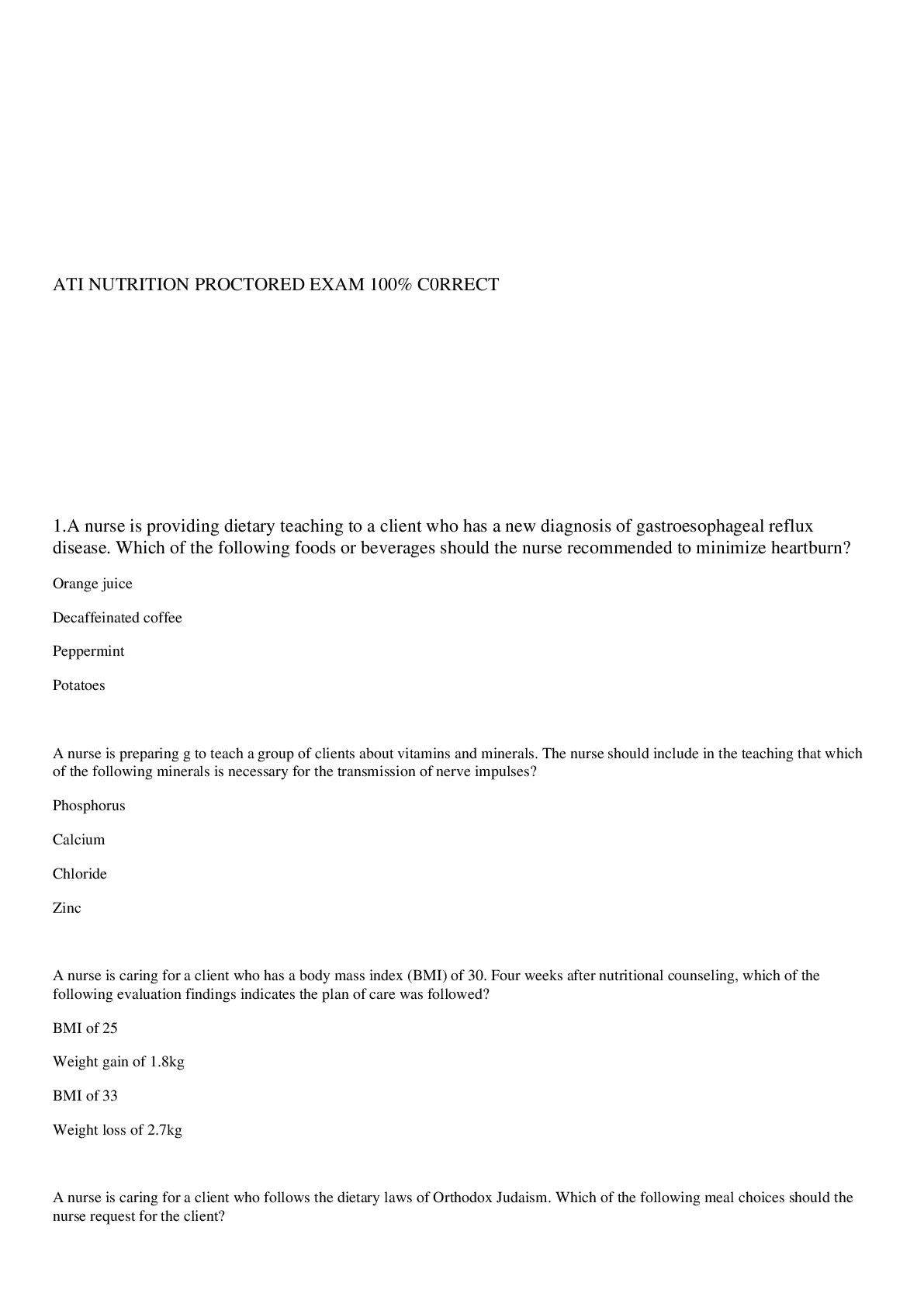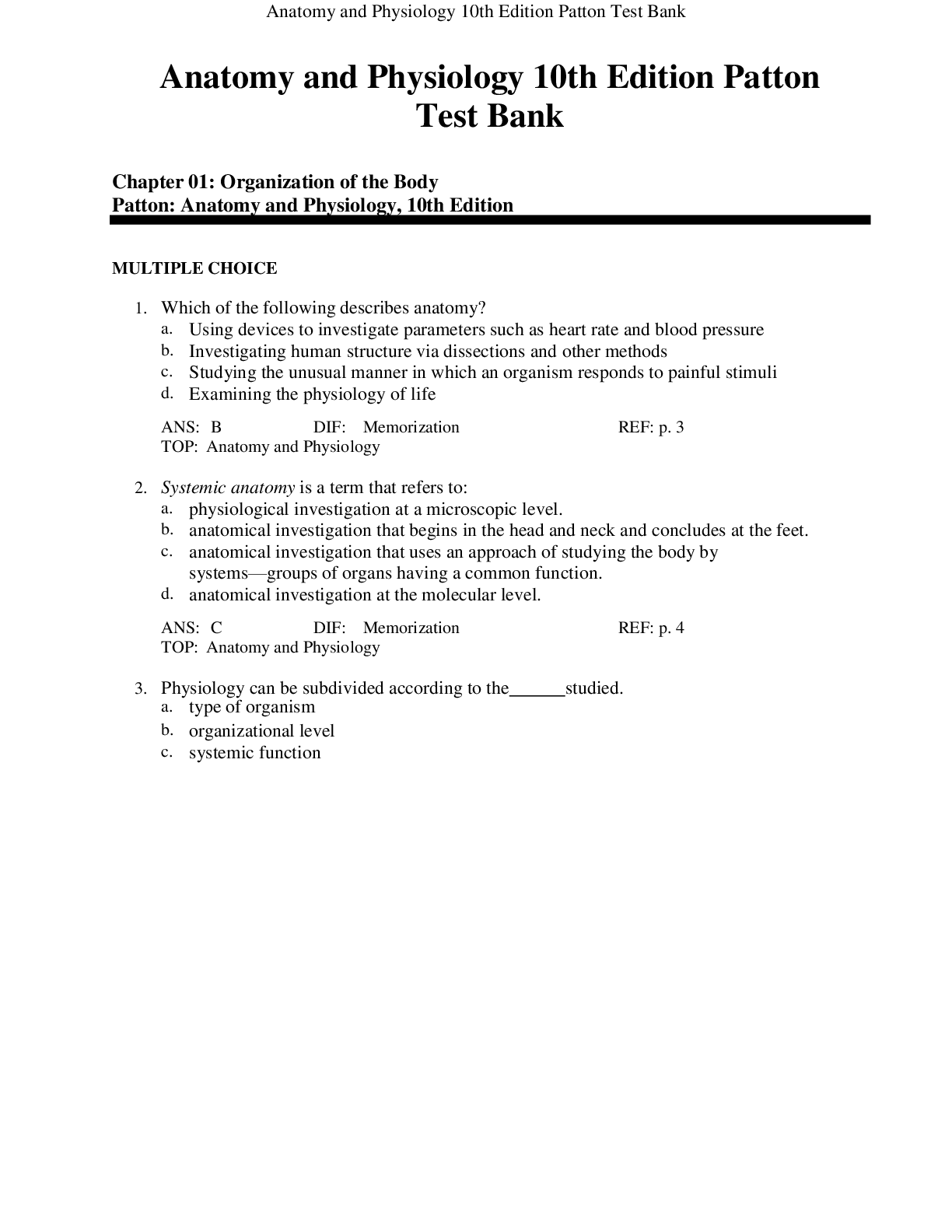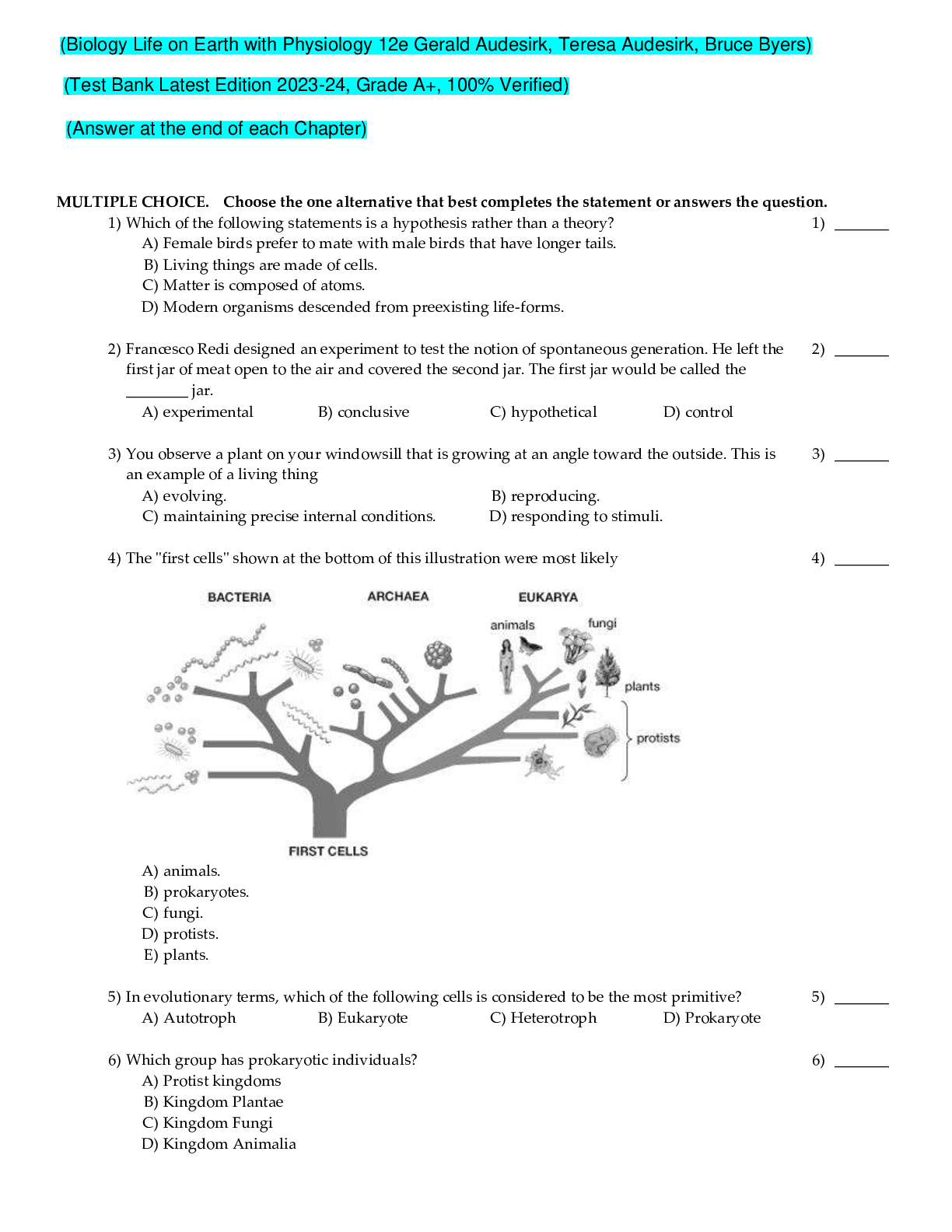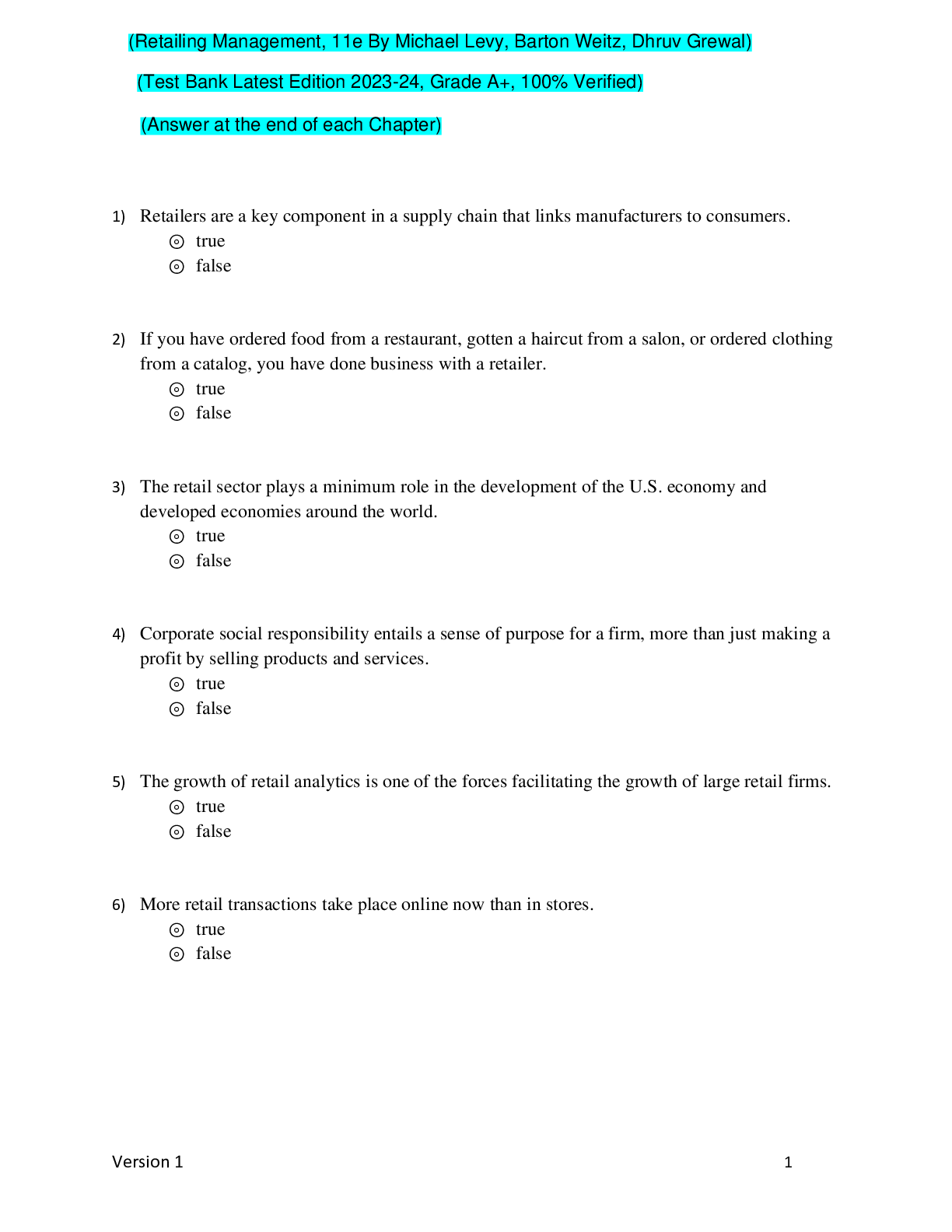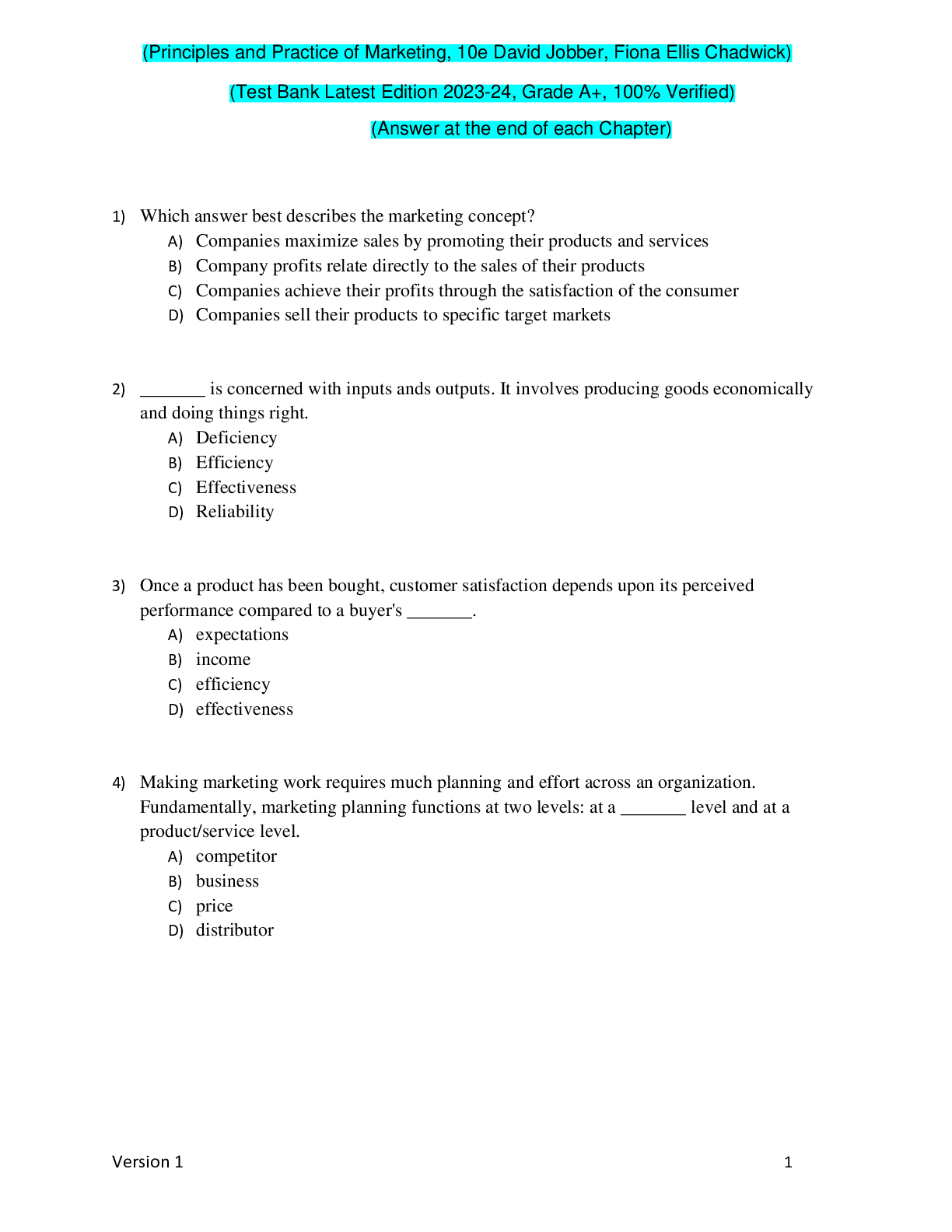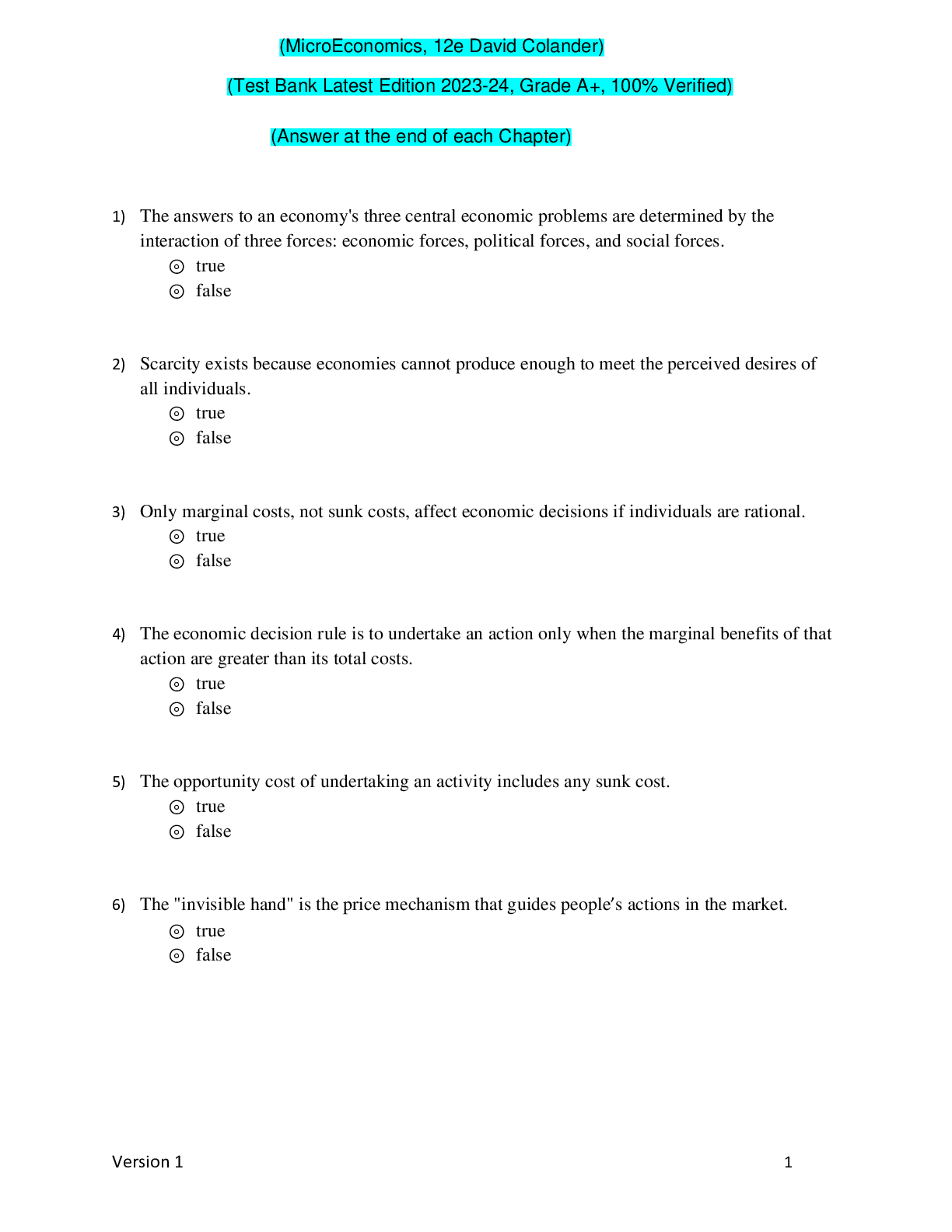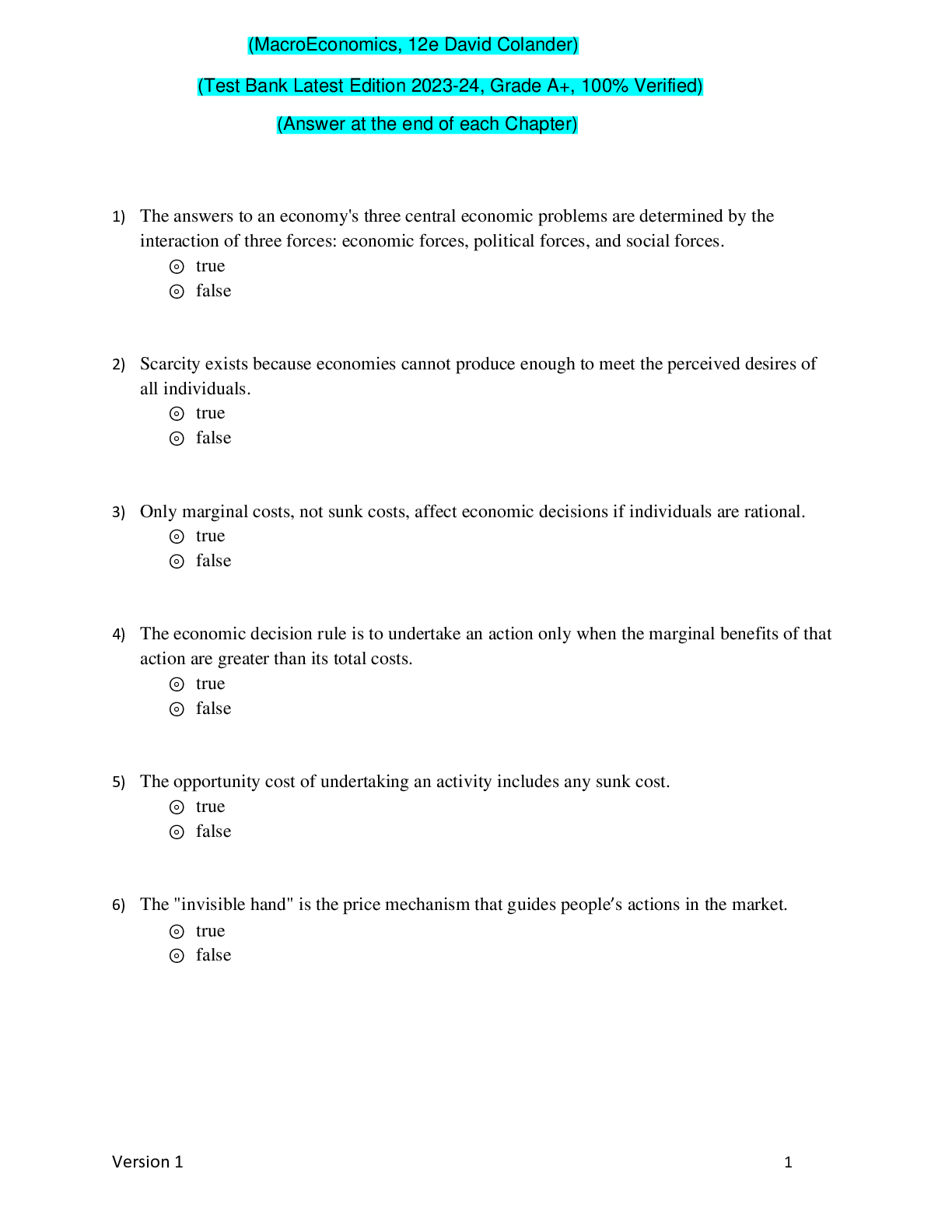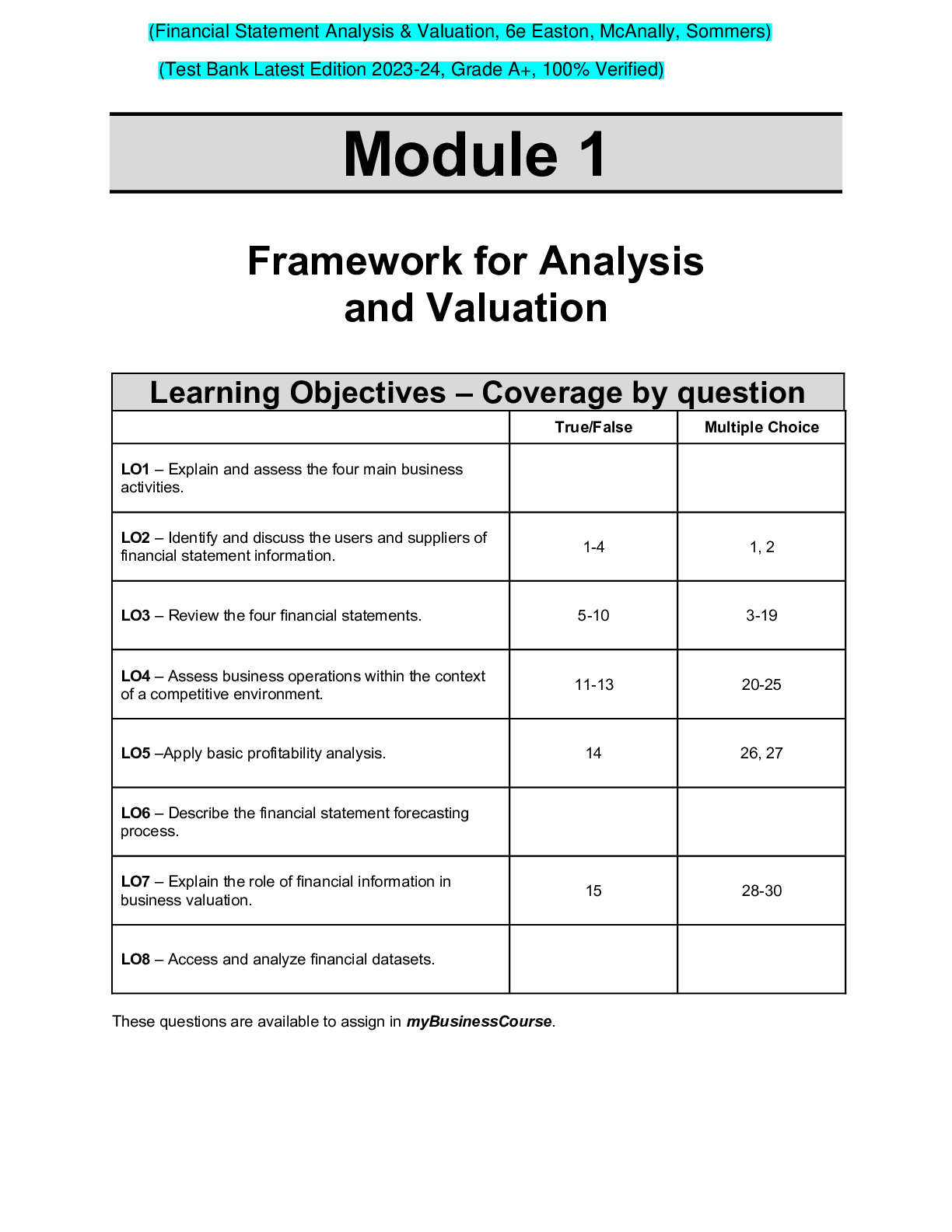CNA 101 Elsevier NCLEX Endocrine Questions And Answers;TOP SCORE
Document Content and Description Below
A client is brought to the emergency department in an unresponsive state, and a diagnosis of hyperosmolar hyperglycemic syndrome is made. The nurse would immediately prepare to initiate which anticip ... ated health care provider's prescription? 1.Endotracheal intubation 2.100 units of NPH insulin 3.Intravenous infusion of normal saline 4.Intravenous infusion of sodium bicarbonate Intravenous infusion of normal saline The primary goal of treatment in hyperosmolar hyperglycemic syndrome (HHS) is to rehydrate the client to restore fluid volume and to correct electrolyte deficiency. Intravenous (IV) fluid replacement is similar to that administered in diabetic ketoacidosis (DKA) and begins with IV infusion of normal saline. Regular insulin, not NPH insulin, would be administered. The use of sodium bicarbonate to correct acidosis is avoided because it can precipitate a further drop in serum potassium levels. Intubation and mechanical ventilation are not required to treat HHS. An external insulin pump is prescribed for a client with diabetes mellitus. When the client asks the nurse about the functioning of the pump, the nurse bases the response on which information about the pump? 1.It is timed to release programmed doses of either short-duration or NPH insulin into the bloodstream at specific intervals. 2.It continuously infuses small amounts of NPH insulin into the bloodstream while regularly monitoring blood glucose levels. 3.It is surgically attached to the pancreas and infuses regular insulin into the pancreas. This releases insulin into the bloodstream. 4. It administers a small continuous dose of short-duration insulin subcutaneously. The client can selfadminister an additional bolus dose from the pump before each meal. It administers a small continuous dose of short-duration insulin subcutaneously. The client can self-administer an additional bolus dose from the pump before each meal. An insulin pump provides a small continuous dose of short-duration (rapid- or short-acting) insulin subcutaneously throughout the day and night. The client can self-administer an additional bolus dose from the pump before each meal as needed. Short-duration insulin is used in an insulin pump. An external pump is not attached surgically to the pancreas. A client with a diagnosis of diabetic ketoacidosis (DKA) is being treated in the emergency department. Which findings support this diagnosis? Select all that apply. 1.Increase in pH 2.Comatose state 3.Deep, rapid breathing 4.Decreased urine output 5.Elevated blood glucose level 2.Comatose state 3.Deep, rapid breathing 5.Elevated blood glucose level Because of the profound deficiency of insulin associated with DKA, glucose cannot be used for energy and the body breaks down fat as a secondary source of energy. Ketones, which are acid byproducts of fat metabolism, build up and the client experiences a metabolic ketoacidosis. High serum glucose contributes to an osmotic diuresis and the client becomes severely dehydrated. If untreated, the client will become comatose due to severe dehydration, acidosis, and electrolyte imbalance. Kussmaul's respirations, the deep rapid breathing associated with DKA, is a compensatory mechanism by the body. The body attempts to correct the acidotic state by blowing off carbon dioxide (CO2), which is an acid. In the absence of insulin, the client will experience severe hyperglycemia. Option 1 is incorrect because in acidosis the pH would be low. Option 4 is incorrect because a high serum glucose will result in an osmotic diuresis and the client will experience polyuria. The nurse teaches a client with diabetes mellitus about differentiating between hypoglycemia and ketoacidosis. The client demonstrates an understanding of the teaching by stating that a form of glucose should be taken if which symptom or symptoms develop? Select all that apply. 1.Polyuria 2.Shakiness 3.Palpitations 4.Blurred vision 5.Lightheadedness 6.Fruity breath odor 2.Shakiness 3.Palpitations 5.Lightheadedness Shakiness, palpitations, and lightheadedness are signs/symptoms of hypoglycemia and would indicate the need for food or glucose. Polyuria, blurred vision, and a fruity breath odor are manifestations of hyperglycemia. A client with diabetes mellitus demonstrates acute anxiety when admitted to the hospital for the treatment of hyperglycemia. What is the appropriate intervention to decrease the client's anxiety? 1.Administer a sedative. 2.Convey empathy, trust, and respect toward the client. 3.Ignore the signs and symptoms of anxiety, anticipating that they will soon disappear. 4.Make sure that the client is familiar with the correct medical terms to promote understanding of what is happening. Convey empathy, trust, and respect toward the client. Anxiety is a subjective feeling of apprehension, uneasiness, or dread. The appropriate intervention is to address the client's feelings related to the anxiety. Administering a sedative is not the most appropriate intervention and does not address the source of the client's anxiety. The nurse should not ignore the client's anxious feelings. Anxiety needs to be managed before meaningful client education can occur. The nurse provides instructions to a client newly diagnosed with type 1 diabetes mellitus. The nurse recognizes accurate understanding of measures to prevent diabetic ketoacidosis when the client makes which statement? 1."I will stop taking my insulin if I'm too sick to eat." 2."I will decrease my insulin dose during times of illness." 3."I will adjust my insulin dose according to the level of glucose in my urine." 4."I will notify my health care provider (HCP) if my blood glucose level is higher than 250 mg/dL (14.2 mmol/L)." "I will notify my health care provider (HCP) if my blood glucose level is higher than 250 mg/dL (14.2 mmol/L)." During illness, the client with type 1 diabetes mellitus is at increased risk of diabetic ketoacidosis, due to hyperglycemia associated with the stress response and due to a typically decreased caloric intake. As part of sick day management, the client with diabetes should monitor blood glucose levels and should notify the HCP if the level is higher than 250 mg/dL (14.2 mmol/L). Insulin should never be stopped. In fact, insulin may need to be increased during times of illness. Doses should not be adjusted without the HCP's advice and are usually adjusted on the basis of blood glucose levels, not urinary glucose readings. A client is admitted to a hospital with a diagnosis of diabetic ketoacidosis (DKA). The initial blood glucose level is 950 mg/dL (54.2 mmol/L). A continuous intravenous (IV) infusion of short-acting insulin is initiated, along with IV rehydration with normal saline. The serum glucose level is now decreased to 240 mg/dL (13.7 mmol/L). The nurse would next prepare to administer which medication? 1.An ampule of 50% dextrose 2.NPH insulin subcutaneously 3.IV fluids containing dextrose 4.Phenytoin for the prevention of seizures IV fluids containing dextrose Emergency management of DKA focuses on correcting fluid and electrolyte imbalances and normalizing the serum glucose level. If the corrections occur too quickly, serious consequences, including hypoglycemia and cerebral edema, can occur. During management of DKA, when the blood glucose level falls to 250 to 300 mg/dL (14.2 to 17.1 mmol/L), the IV infusion rate is reduced and a dextrose solution is added to maintain a blood glucose level of about 250 mg/dL (14.2 mmol/L), or until the client recovers from ketosis. Fifty percent dextrose is used to treat hypoglycemia. NPH insulin is not used to treat DKA. Phenytoin is not a usual treatment measure for DKA. The nurse is monitoring a client newly diagnosed with diabetes mellitus for signs of complications. Which sign or symptom, if exhibited in the client, indicates that the client is at risk for chronic complications of diabetes if the blood glucose is not adequately managed? 1.Polyuria 2.Diaphoresis 3.Pedal edema 4.Decreased respiratory rate Polyuria Chronic hyperglycemia, resulting from poor glycemic control, contributes to the microvascular and macrovascular complications of diabetes mellitus. Classic symptoms of hyperglycemia include polydipsia, polyuria, and polyphagia. Diaphoresis may occur in hypoglycemia. Hypoglycemia is an acute complication of diabetes mellitus; however, it does not predispose a client to the chronic complications of diabetes mellitus. Therefore, option 2 can be eliminated because this finding is characteristic of hypoglycemia. Options 3 and 4 are not associated with diabetes mellitus. The nurse is preparing a plan of care for a client with diabetes mellitus who has hyperglycemia. The nurse places priority on which client problem? 1.Lack of knowledge 2.Inadequate fluid volume 3.Compromised family coping 4.Inadequate consumption of nutrients Inadequate fluid volume An increased blood glucose level will cause the kidneys to excrete the glucose in the urine. This glucose is accompanied by fluids and electrolytes, causing an osmotic diuresis leading to dehydration. This fluid loss must be replaced when it becomes severe. Options 1, 3, and 4 are not related specifically to the information in the question. The home health nurse visits a client with a diagnosis of type 1 diabetes mellitus. The client relates a history of vomiting and diarrhea and tells the nurse that no food has been consumed for the last 24 hours. Which additional statement by the client indicates a need for further teaching? 1."I need to stop my insulin." 2."I need to increase my fluid intake." 3."I need to monitor my blood glucose every 3 to 4 hours." 4."I need to call the health care provider (HCP) because of these symptoms." "I need to stop my insulin." When a client with diabetes mellitus is unable to eat normally because of illness, the client still should take the prescribed insulin or oral medication. The client should consume additional fluids and should notify the HCP. The client should monitor the blood glucose level every 3 to 4 hours. The client should also monitor the urine for ketones during illness. The nurse is caring for a client after hypophysectomy and notes clear nasal drainage from the client's nostril. The nurse should take which initial action? 1.Lower the head of the bed. 2.Test the drainage for glucose. 3.Obtain a culture of the drainage. 4.Continue to observe the drainage. Test the drainage for glucose. After hypophysectomy, the client should be monitored for rhinorrhea, which could indicate a cerebrospinal fluid leak. If this occurs, the drainage should be collected and tested for the presence of cerebrospinal fluid. Cerebrospinal fluid contains glucose, and if positive, this would indicate that the drainage is cerebrospinal fluid. The head of the bed should remain elevated to prevent increased intracranial pressure. Clear nasal drainage would not indicate the need for a culture. Continuing to observe the drainage without taking action could result in a serious complication. The nurse is admitting a client who is diagnosed with syndrome of inappropriate antidiuretic hormone secretion (SIADH) and has serum sodium of 118 mEq/L (118 mmol/L). Which health care provider prescriptions should the nurse anticipate receiving? Select all that apply. 1.Initiate an infusion of 3% NaCl. 2.Administer intravenous furosemide. 3.Restrict fluids to 800 mL over 24 hours. 4.Elevate the head of the bed to high Fowler's. 5.Administer a vasopressin antagonist as prescribed. 1.Initiate an infusion of 3% NaCl. 3.Restrict fluids to 800 mL over 24 hours. 5.Administer a vasopressin antagonist as prescribed Clients with SIADH experience excess secretion of antidiuretic hormone (ADH), which leads to excess intravascular volume, a declining serum osmolarity, and dilutional hyponatremia. Management is directed at correcting the hyponatremia and preventing cerebral edema. Hypertonic saline is prescribed when the hyponatremia is severe, less than 120 mEq/L (120 mmol/L). An intravenous (IV) infusion of 3% saline is hypertonic. Hypertonic saline must be infused slowly as prescribed and an infusion pump must be used. Fluid restriction is a useful strategy aimed at correcting dilutional hyponatremia. Vasopressin is an ADH; vasopressin antagonists are used to treat SIADH. Furosemide may be used to treat extravascular volume and dilutional hyponatremia in SIADH, but it is only safe to use if the serum sodium is at least 125 mEq/L (125 mmol/L). When furosemide is used, potassium supplementation should also occur and serum potassium levels should be monitored. To promote venous return, the head of the bed should not be raised more than 10 degrees for the client with SIADH. Maximizing venous return helps to avoid stimulating stretch receptors in the heart that signal to the pituitary that more ADH is needed. A client is admitted to an emergency department, and a diagnosis of myxedema coma is made. Which action should the nurse prepare to carry out initially? 1.Warm the client. 2.Maintain a patent airway. 3.Administer thyroid hormone. 4.Administer fluid replacement. Maintain a patent airway. Myxedema coma is a rare but serious disorder that results from persistently low thyroid production. Coma can be precipitated by acute illness, rapid withdrawal of thyroid medication, anesthesia and surgery, hypothermia, and the use of sedatives and opioid analgesics. In myxedema coma, the initial nursing action is to maintain a patent airway. Oxygen should be administered, followed by fluid replacement, keeping the client warm, monitoring vital signs, and administering thyroid hormones by the intravenous route. The nurse is caring for a client admitted to the emergency department with diabetic ketoacidosis (DKA). In the acute phase, the nurse plans for which priority intervention? 1.Correct the acidosis. 2.Administer 5% dextrose intravenously. 3.Apply a monitor for an electrocardiogram. 4.Administer short-duration insulin intravenously. Administer short-duration insulin intravenously. Lack of insulin (absolute or relative) is the primary cause of DKA. Treatment consists of insulin administration (short- or rapid-acting), intravenous fluid administration (normal saline initially, not 5% dextrose), and potassium replacement, followed by correcting acidosis. Cardiac monitoring is important due to alterations in potassium levels associated with DKA and its treatment, but applying an electrocardiogram monitor is not the priority action. A client with type 1 diabetes mellitus calls the nurse to report recurrent episodes of hypoglycemia with exercising. Which statement by the client indicates an adequate understanding of the peak action of NPH insulin and exercise? 1."I should not exercise since I am taking insulin." 2."The best time for me to exercise is after breakfast." 3."The best time for me to exercise is mid- to late afternoon." 4."NPH is a basal insulin, so I should exercise in the evening." "The best time for me to exercise is after breakfast." Exercise is an important part of diabetes management. It promotes weight loss, decreases insulin resistance, and helps to control blood glucose levels. A hypoglycemic reaction may occur in response to increased exercise, so clients should exercise either an hour after mealtime or after consuming a 10- to 15-gram carbohydrate snack, and they should check their blood glucose level before exercising. Option 1 is incorrect because clients with diabetes should exercise, though they should check with their health care provider before starting a new exercise program. Option 3 in incorrect; clients should avoid exercise during the peak time of insulin. NPH insulin peaks at 4 to 12 hours; therefore, afternoon exercise takes place during the peak of the medication. Options 4 is incorrect; NPH insulin in an intermediate-acting insulin, not a basal insulin. The nurse is completing an assessment on a client who is being admitted for a diagnostic workup for primary hyperparathyroidism. Which client complaint would be characteristic of this disorder? Select all that apply. 1.Polyuria 2.Headache 3.Bone pain 4.Nervousness 5.Weight gain 1.Polyuria 3.Bone pain The role of parathyroid hormone (PTH) in the body is to maintain serum calcium homeostasis. In hyperparathyroidism, PTH levels are high, which causes bone resorption (calcium is pulled from the bones). Hypercalcemia occurs with hyperparathyroidism. Elevated serum calcium levels produce osmotic diuresis and thus polyuria. This diuresis leads to dehydration (weight loss rather than weight gain). Loss of calcium from the bones causes bone pain. Options 2, 4, and 5 are not associated with hyperparathyroidism. Some gastrointestinal symptoms include anorexia, nausea, vomiting, and constipation. The nurse is teaching a client with hyperparathyroidism how to manage the condition at home. Which response by the client indicates the need for additional teaching? 1."I should limit my fluids to 1 liter per day." 2."I should use my treadmill or go for walks daily." 3."I should follow a moderate-calcium, high-fiber diet." 4."My alendronate helps to keep calcium from coming out of my bones." "I should limit my fluids to 1 liter per day." In hyperparathyroidism, clients experience excess parathyroid hormone (PTH) secretion. A role of PTH in the body is to maintain serum calcium homeostasis. When PTH levels are high, there is excess bone resorption (calcium is pulled from the bones). In clients with elevated serum calcium levels, there is a risk of nephrolithiasis. One to 2 liters of fluids daily should be encouraged to protect the kidneys and decrease the risk of nephrolithiasis. Moderate physical activity, particularly weight-bearing activity, minimizes bone resorption and helps to protect against pathological fracture. Walking, as an exercise, should be encouraged in the client with hyperparathyroidism. Clients should follow a moderate-calcium, high-fiber diet. Even though serum calcium is already high, clients should follow a moderate-calcium diet because a low-calcium diet will surge PTH. Calcium causes constipation, so a diet high in fiber is recommended. Alendronate is a bisphosphate that inhibits bone resorption. In bone resorption, bone is broken down and calcium is deposited into the serum. A client with a diagnosis of Addisonian crisis is being admitted to the intensive care unit. Which findings will the interprofessional health care team focus on? Select all that apply. 1.Hypotension 2.Leukocytosis 3.Hyperkalemia 4.Hypercalcemia 5.Hypernatremia 1.Hypotension 3.Hyperkalemia In Addison's disease, also known as adrenal insufficiency, destruction of the adrenal gland leads to decreased production of adrenocortical hormones, including the glucocorticoid cortisol and the mineralocorticoid aldosterone. Addisonian crisis, also known as acute adrenal insufficiency, occurs when there is extreme physical or emotional stress and lack of sufficient adrenocortical hormones to manage the stressor. Addisonian crisis is a life-threatening emergency. One of the roles of endogenous cortisol is to enhance vascular tone and vascular response to the catecholamines epinephrine and norepinephrine. Hypotension occurs when vascular tone is decreased and blood vessels cannot respond to epinephrine and norepinephrine. The role of aldosterone in the body is to support the blood pressure by holding salt and water and excreting potassium. When there is insufficient aldosterone, salt and water are lost and potassium builds up; this leads to hypotension from decreased vascular volume, hyponatremia, and hyperkalemia. The remaining options are not associated with Addisonian crisis. The nurse is monitoring a client who was diagnosed with type 1 diabetes mellitus and is being treated with NPH and regular insulin. Which manifestations would alert the nurse to the presence of a possible hypoglycemic reaction? Select all that apply. 1.Tremors 2.Anorexia 3.Irritability 4.Nervousness 5.Hot, dry skin 6.Muscle cramps 1.Tremors 3.Irritability 4.Nervousness Decreased blood glucose levels produce autonomic nervous system symptoms, which are manifested classically as nervousness, irritability, and tremors. Option 5 is more likely to occur with hyperglycemia. Options 2 and 6 are unrelated to the manifestations of hypoglycemia. In hypoglycemia, usually the client feels hunger. The nurse is performing an assessment on a client with pheochromocytoma. Which assessment data would indicate a potential complication associated with this disorder? 1.A urinary output of 50 mL/hour 2.A coagulation time of 5 minutes 3.A heart rate that is 90 beats/minute and irregular 4.A blood urea nitrogen level of 20 mg/dL (7.1 mmol/L) A heart rate that is 90 beats/minute and irregular Pheochromocytoma is a catecholamine-producing tumor usually found in the adrenal medulla, but extraadrenal locations include the chest, bladder, abdomen, and brain; it is typically a benign tumor but can be malignant. Excessive amounts of epinephrine and norepinephrine are secreted. The complications associated with pheochromocytoma include hypertensive retinopathy and nephropathy, myocarditis, increased platelet aggregation, and stroke. Death can occur from shock, stroke, kidney failure, dysrhythmias, or dissecting aortic aneurysm. An irregular heart rate indicates the presence of a dysrhythmia. A coagulation time of 5 minutes is normal. A urinary output of 50 mL/hour is an adequate output. A blood urea nitrogen level of 20 mg/dL (7.1 mmol/L) is a normal finding. The nurse is monitoring a client diagnosed with acromegaly who was treated with transsphenoidal hypophysectomy and is recovering in the intensive care unit. Which findings should alert the nurse to the presence of a possible postoperative complication? Select all that apply. 1.Anxiety 2.Leukocytosis 3.Chvostek's sign 4.Urinary output of 800 mL/hour 5.Clear drainage on nasal dripper pad 2.Leukocytosis 4.Urinary output of 800 mL/hour 5.Clear drainage on nasal dripper pad Acromegaly results from excess secretion of growth hormone, usually caused by a benign tumor on the anterior pituitary gland. Treatment is surgical removal of the tumor, usually with a sublingual transsphenoidal complete or partial hypophysectomy. The sublingual transsphenoidal approach is often through an incision in the inner upper lip at the gum line. Transsphenoidal surgery is a type of brain surgery and infection is a primary concern. Leukocytosis, or an elevated white count, may indicate infection. Diabetes insipidus is a possible complication of transsphenoidal hypophysectomy. In diabetes insipidus there is decreased secretion of antidiuretic hormone and clients excrete large amounts of dilute urine. Following transsphenoidal surgery, the nasal passages are packed and a dripper pad is secured under the nares. Clear drainage on the dripper pad is suggestive of a cerebrospinal fluid leak. The surgeon should be notified and the drainage should be tested for glucose. A cerebrospinal fluid leak increases the postoperative risk of meningitis. Anxiety is a nonspecific finding that is common to many disorders. Chvostek's sign is a test of nerve hyperexcitability associated with hypocalcemia and is seen as grimacing in response to tapping on the facial nerve. Chvostek's sign has no association with complications of sublingual transsphenoidal hypophysectomy. The nurse performs a physical assessment on a client with type 2 diabetes mellitus. Findings include a fasting blood glucose level of 120 mg/dL (6.8 mmol/L), temperature of 101°F (38.3°C), pulse of 102 beats/minute, respirations of 22 breaths/minute, and blood pressure of 142/72 mm Hg. Which finding would be the priority concern to the nurse? 1.Pulse 2.Respiration 3.Temperature 4.Blood pressure Temperature In the client with type 2 diabetes mellitus, an elevated temperature may indicate infection. Infection is a leading cause of hyperosmolar hyperglycemic syndrome in the client with type 2 diabetes mellitus. The other findings are within normal limits. The nurse is preparing a client with a new diagnosis of hypothyroidism for discharge. The nurse determines that the client understands discharge instructions if the client states that which signs and symptoms are associated with this diagnosis? Select all that apply. 1.Tremors 2.Weight loss 3.Feeling cold 4.Loss of body hair 5.Persistent lethargy 6.Puffiness of the face 3.Feeling cold 4.Loss of body hair 5.Persistent lethargy 6.Puffiness of the face Feeling cold, hair loss, lethargy, and facial puffiness are signs of hypothyroidism. Tremors and weight loss are signs of hyperthyroidism. A client has just been admitted to the nursing unit following thyroidectomy. Which assessment is the priority for this client? 1.Hypoglycemia 2.Level of hoarseness 3.Respiratory distress 4.Edema at the surgical site Respiratory distress Thyroidectomy is the removal of the thyroid gland, which is located in the anterior neck. It is very important to monitor airway status, as any swelling to the surgical site could cause respiratory distress. Although all of the options are important for the nurse to monitor, the priority nursing action is to monitor the airway. A client has been diagnosed with hyperthyroidism. The nurse monitors for which signs and symptoms indicating a complication of this disorder? Select all that apply. 1.Fever 2.Nausea 3.Lethargy 4.Tremors 5.Confusion 6.Bradycardia 1.Fever 2.Nausea 4.Tremors 5.Confusion Thyroid storm is an acute and life-threatening complication that occurs in a client with uncontrollable hyperthyroidism. Signs and symptoms of thyroid storm include elevated temperature (fever), nausea, and tremors. In addition, as the condition progresses, the client becomes confused. The client is restless and anxious and experiences tachycardia. The nurse is caring for a client scheduled for a transsphenoidal hypophysectomy. The preoperative teaching instructions should include which statement? 1."Your hair will need to be shaved." 2."You will receive spinal anesthesia." 3."You will need to ambulate after surgery." 4."Brushing your teeth needs to be avoided for at least 2 weeks after surgery." "Brushing your teeth needs to be avoided for at least 2 weeks after surgery." A transsphenoidal hypophysectomy is a surgical approach that uses the nasal sinuses and nose for access to the pituitary gland. Based on the location of the surgical procedure, spinal anesthesia would not be used. In addition, the hair would not be shaved. Although ambulating is important, specific to this procedure is avoiding brushing the teeth to prevent disruption of the surgical site. The nurse should include which interventions in the plan of care for a client with hypothyroidism? Select all that apply. 1.Provide a cool environment for the client. 2.Instruct the client to consume a high-fat diet. 3.Instruct the client about thyroid replacement therapy. 4.Encourage the client to consume fluids and high-fiber foods in the diet. 5.Inform the client that iodine preparations will be prescribed to treat the disorder. 6.Instruct the client to contact the health care provider (HCP) if episodes of chest pain occur. 3.Instruct the client about thyroid replacement therapy. 4.Encourage the client to consume fluids and high-fiber foods in the diet. 6.Instruct the client to contact the health care provider (HCP) if episodes of chest pain occur. The clinical manifestations of hypothyroidism are the result of decreased metabolism from low levels of thyroid hormone. Interventions are aimed at replacement of the hormone and providing measures to support the signs and symptoms related to decreased metabolism. The client often has cold intolerance and requires a warm environment. The nurse encourages the client to consume a well-balanced diet that is low in fat for weight reduction and high in fluids and high-fiber foods to prevent constipation. Iodine preparations may be used to treat hyperthyroidism. Iodine preparations decrease blood flow through the thyroid gland and reduce the production and release of thyroid hormone; they are not used to treat hypothyroidism. The client is instructed to notify the HCP if chest pain occurs because it could be an indication of overreplacement of thyroid hormone. A client with Cushing's syndrome verbalizes concern to the nurse regarding the appearance of the buffalo hump that has developed. Which statement should the nurse make to the client? 1."Don't be concerned; this problem can be covered with clothing." 2."Usually these physical changes slowly improve following treatment." 3."This is permanent, but looks are deceiving and are not that important." 4."Try not to worry about it; there are other things to be concerned about." "Usually these physical changes slowly improve following treatment." The client with Cushing's syndrome should be reassured that most physical changes resolve with treatment. All other options are not therapeutic responses. The nurse is caring for a client after thyroidectomy. The nurse notes that calcium gluconate is prescribed for the client. The nurse determines that this medication has been prescribed for which purpose? 1.To treat thyroid storm 2.To prevent cardiac irritability 3.To treat hypocalcemic tetany 4.To stimulate release of parathyroid hormone To treat hypocalcemic tetany Hypocalcemia, resulting in tetany, can develop after thyroidectomy if the parathyroid glands are accidentally removed during surgery. Manifestations develop 1 to 7 days after surgery. If the client develops numbness and tingling around the mouth, fingertips, or toes; muscle spasms; or twitching, the health care provider is notified immediately. Calcium gluconate should be readily available in the nursing unit. A client with type 1 diabetes mellitus is to begin an exercise program, and the nurse is providing instructions regarding the program. Which instruction should the nurse include in the teaching plan? 1.Try to exercise before mealtimes. 2.Administer insulin after exercising. 3.Take a blood glucose test before exercising. 4.Exercise is best performed during peak times of insulin. Take a blood glucose test before exercising. A blood glucose test performed before exercising provides the client with information regarding the need to consume a snack before exercising. Exercising during the peak times of insulin or before mealtime places the client at risk for hypoglycemia. Insulin should be administered as prescribed. The nurse should include which interventions in the plan of care for a client with hyperthyroidism? Select all that apply. 1.Provide a warm environment for the client. 2.Instruct the client to consume a low-fat diet. 3.A thyroid-releasing inhibitor will be prescribed. 4.Encourage the client to consume a well-balanced diet. 5.Instruct the client that thyroid replacement therapy will be needed. 6.Instruct the client that episodes of chest pain are expected to occur. 3.A thyroid-releasing inhibitor will be prescribed. 4. Encourage the client to consume a well-balanced diet. The clinical manifestations of hyperthyroidism are the result of increased metabolism caused by high levels of thyroid hormone. Interventions are aimed at reduction of the hormones and measures to support the signs and symptoms related to an increased metabolism. The client often has heat intolerance and requires a cool environment. The nurse encourages the client to consume a well-balanced diet because clients with this condition experience increased appetite. Iodine preparations are used to treat hyperthyroidism. Iodine preparations decrease blood flow through the thyroid gland and reduce the production and release of thyroid hormone. Thyroid replacement is needed for hypothyroidism. The client would notify the health care provider if chest pain occurs because it could be an indication of an excessive medication dose. A client with diabetes mellitus is being discharged following treatment for hyperosmolar hyperglycemic syndrome (HHS) precipitated by acute illness. The client tells the nurse, "I will call the health care provider (HCP) the next time I can't eat for more than a day or so." Which statement reflects the most appropriate analysis of this client's level of knowledge? 1.The client needs immediate education before discharge. 2.The client requires follow-up teaching regarding the administration of oral antidiabetics. 3.The client's statement is inaccurate, and he or she should be scheduled for outpatient diabetic counseling. 4.The client's statement is inaccurate, and he or she should be scheduled for educational home health visits. The client needs immediate education before discharge. If the client becomes ill and cannot retain fluids or food for a period of 4 hours, the HCP should be notified. The client's statement indicates a need for immediate education to prevent hyperosmolar hyperglycemic syndrome (HHS), a life-threatening emergency. Although all of the other options may be true, the most appropriate analysis is that the client requires immediate education. A client with type 1 diabetes mellitus is having trouble remembering the types, duration, and onset of the action of insulin. The client tells the nurse that family members have not been supportive. Which response by the nurse is best? 1."What is it that you don't understand?" 2."You can't always depend on your family to help." 3."It's not really necessary for you to remember this." 4."Let me go over the types of insulins with you again." "Let me go over the types of insulins with you again." Reinforcement of knowledge and behaviors is vital to the success of the client's self-care. All of the other options do not address the need for client instructions and are not therapeutic responses. A client arrives in the hospital emergency department in an unconscious state. As reported by the spouse, the client has diabetes mellitus and began to show symptoms of hypoglycemia. A blood glucose level is obtained for the client, and the result is 40 mg/dL (2.28 mmol/L). Which medication should the nurse anticipate will be prescribed for the client? [Show More]
Last updated: 11 months ago
Preview 1 out of 48 pages
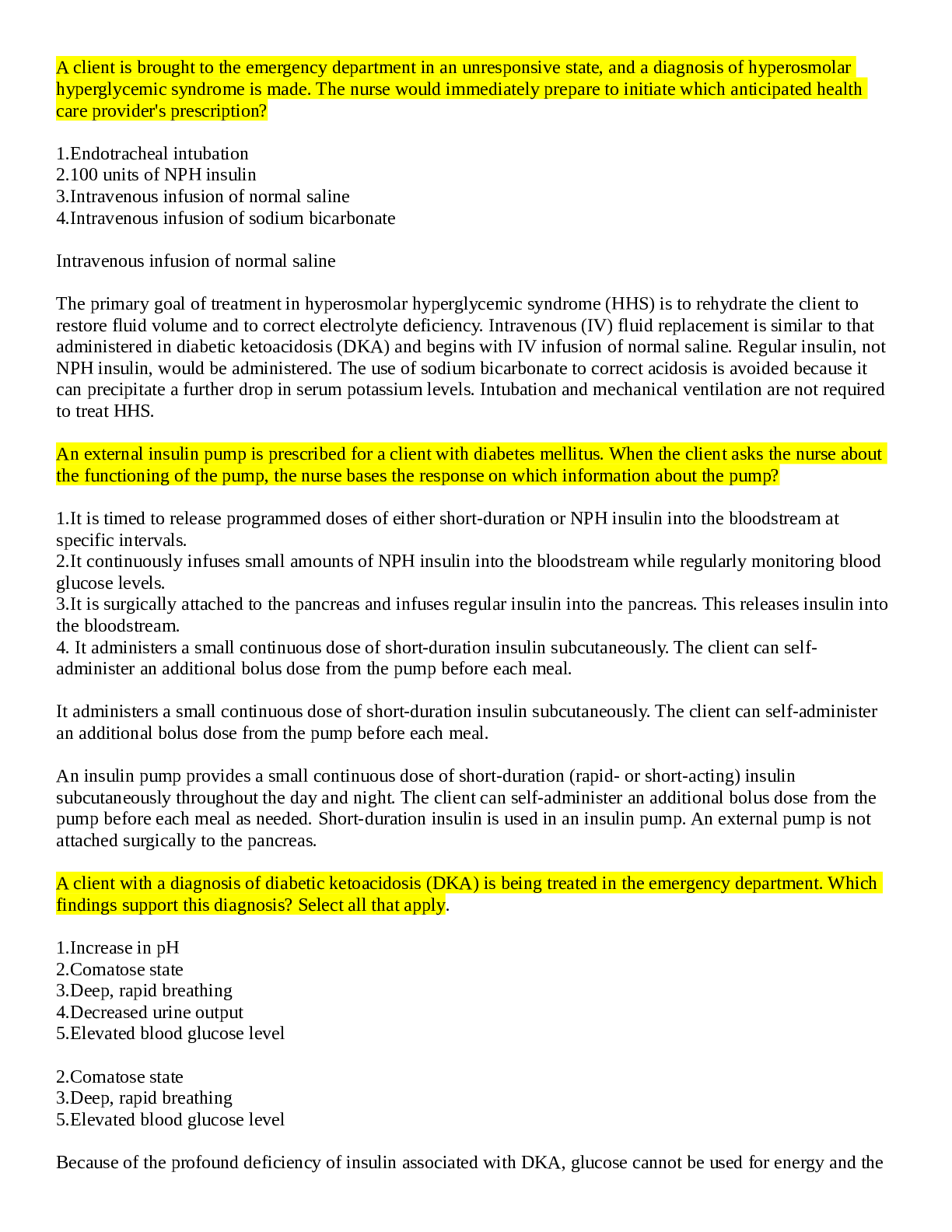
Reviews( 0 )
Document information
Connected school, study & course
About the document
Uploaded On
Feb 28, 2022
Number of pages
48
Written in
Additional information
This document has been written for:
Uploaded
Feb 28, 2022
Downloads
0
Views
48


.png)
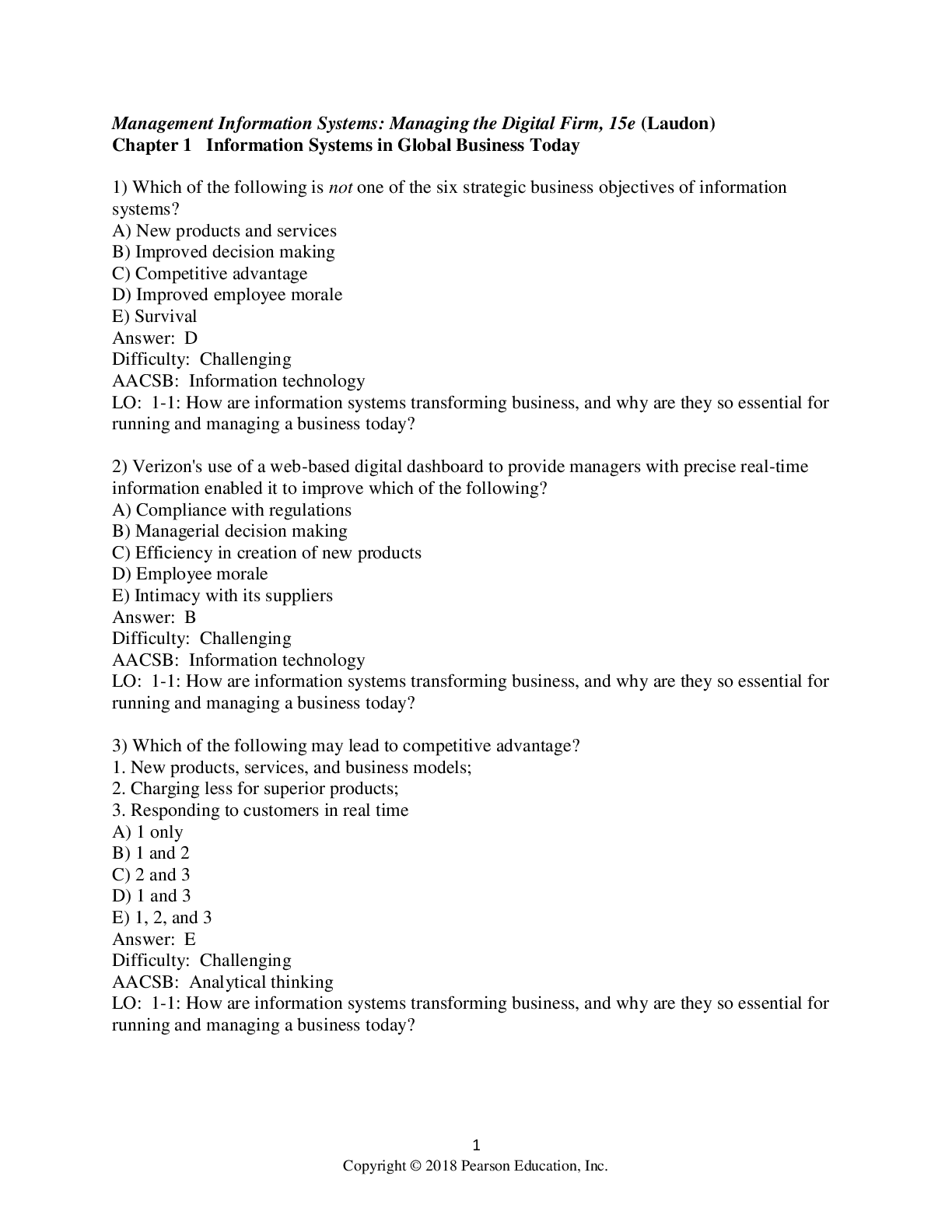
.png)
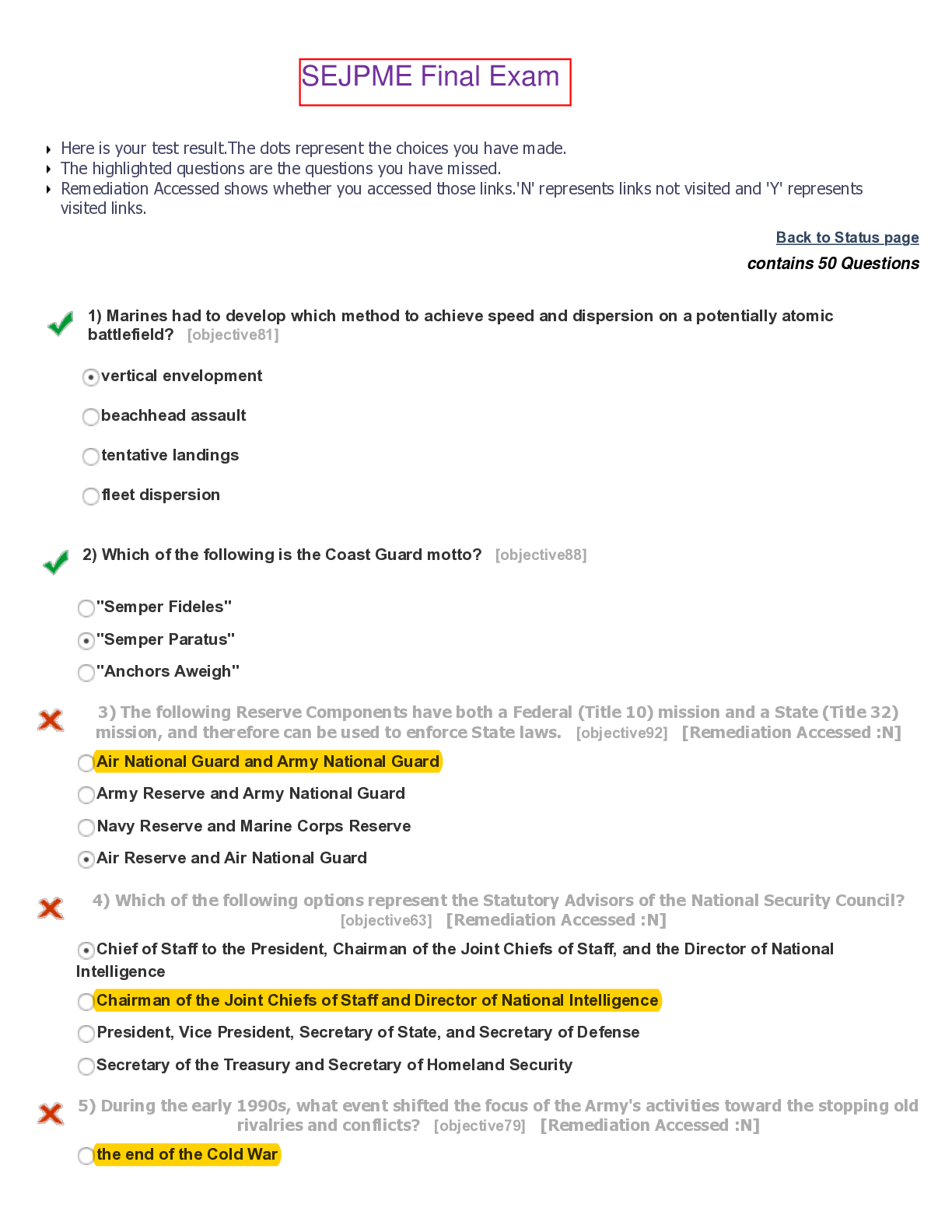

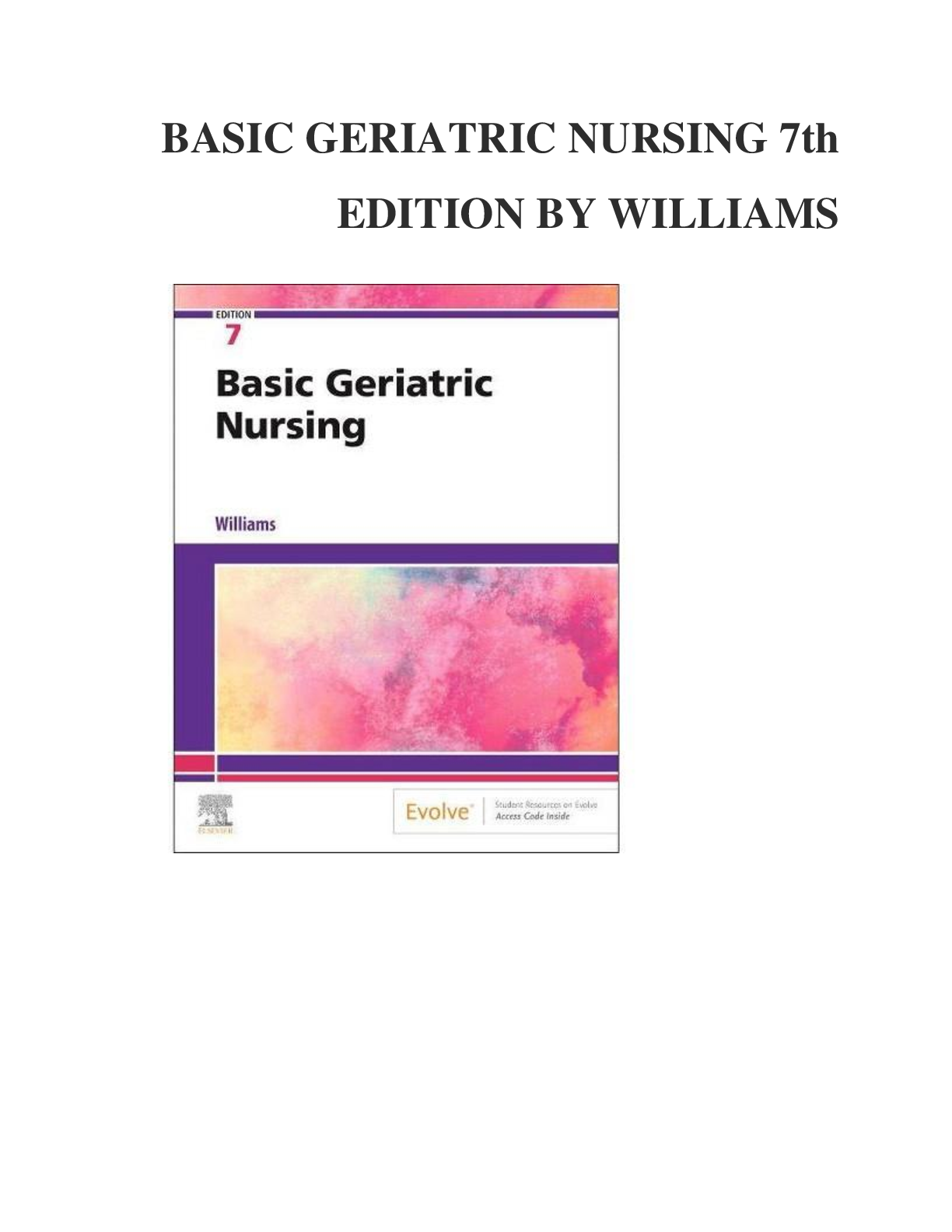
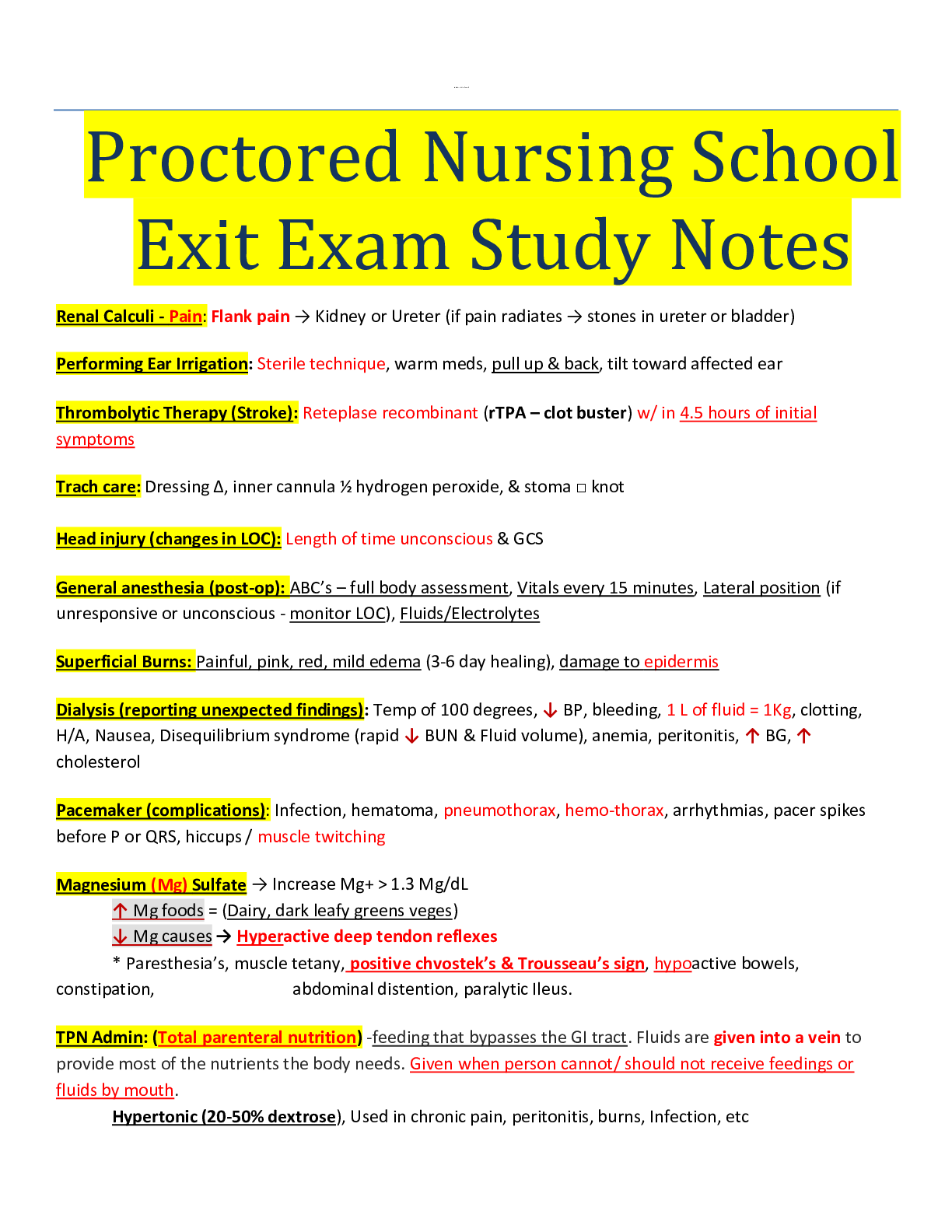
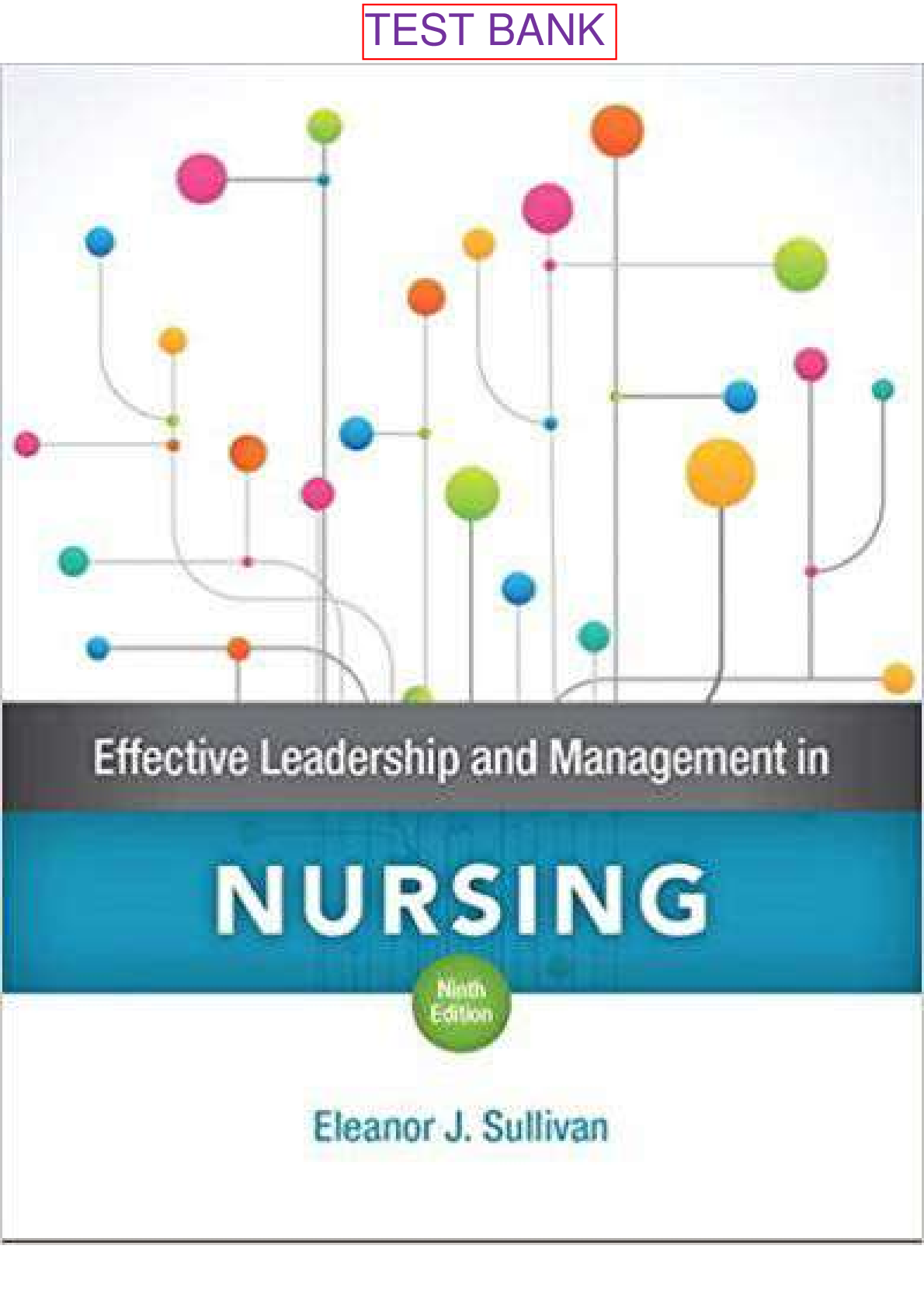
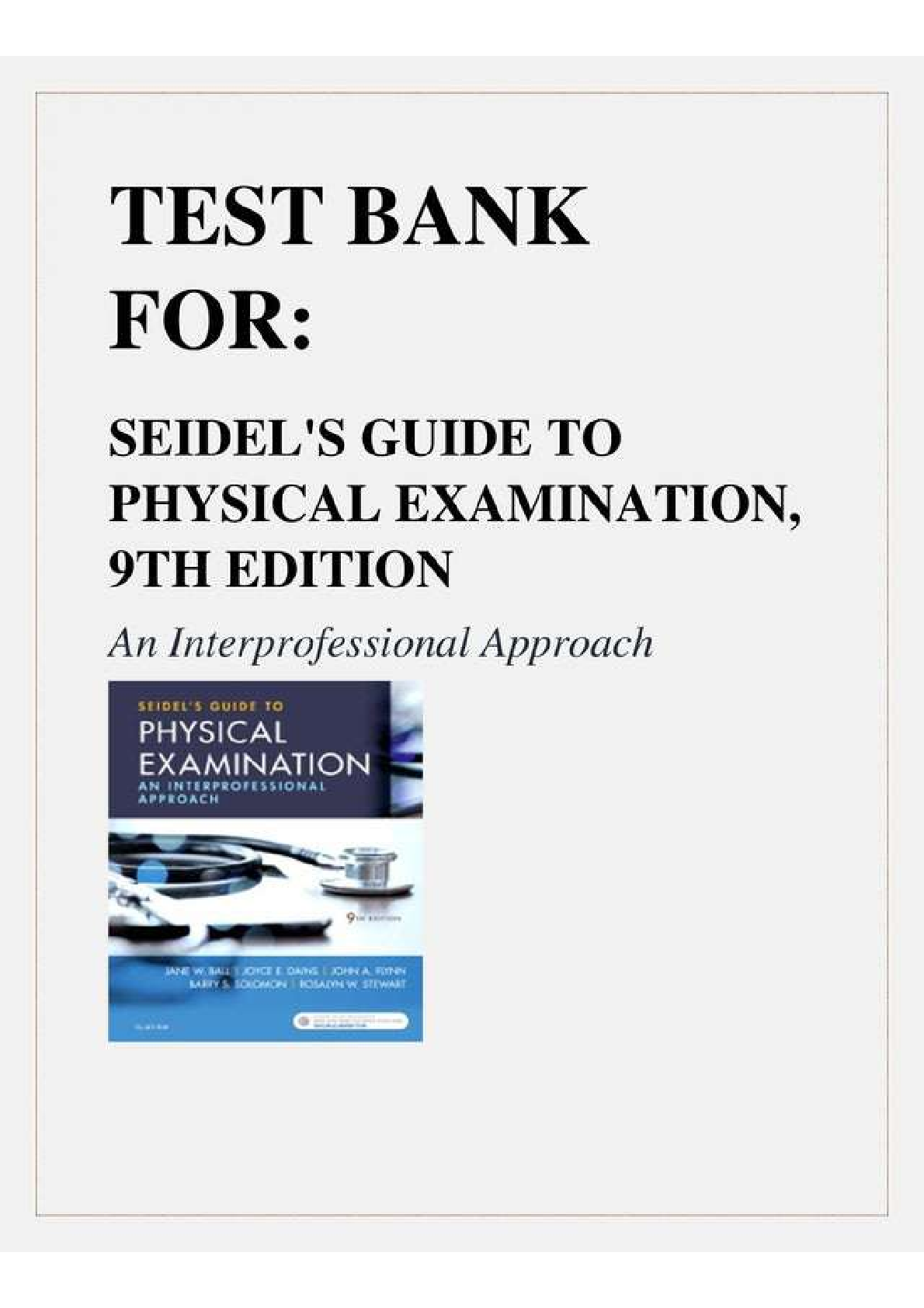
.png)
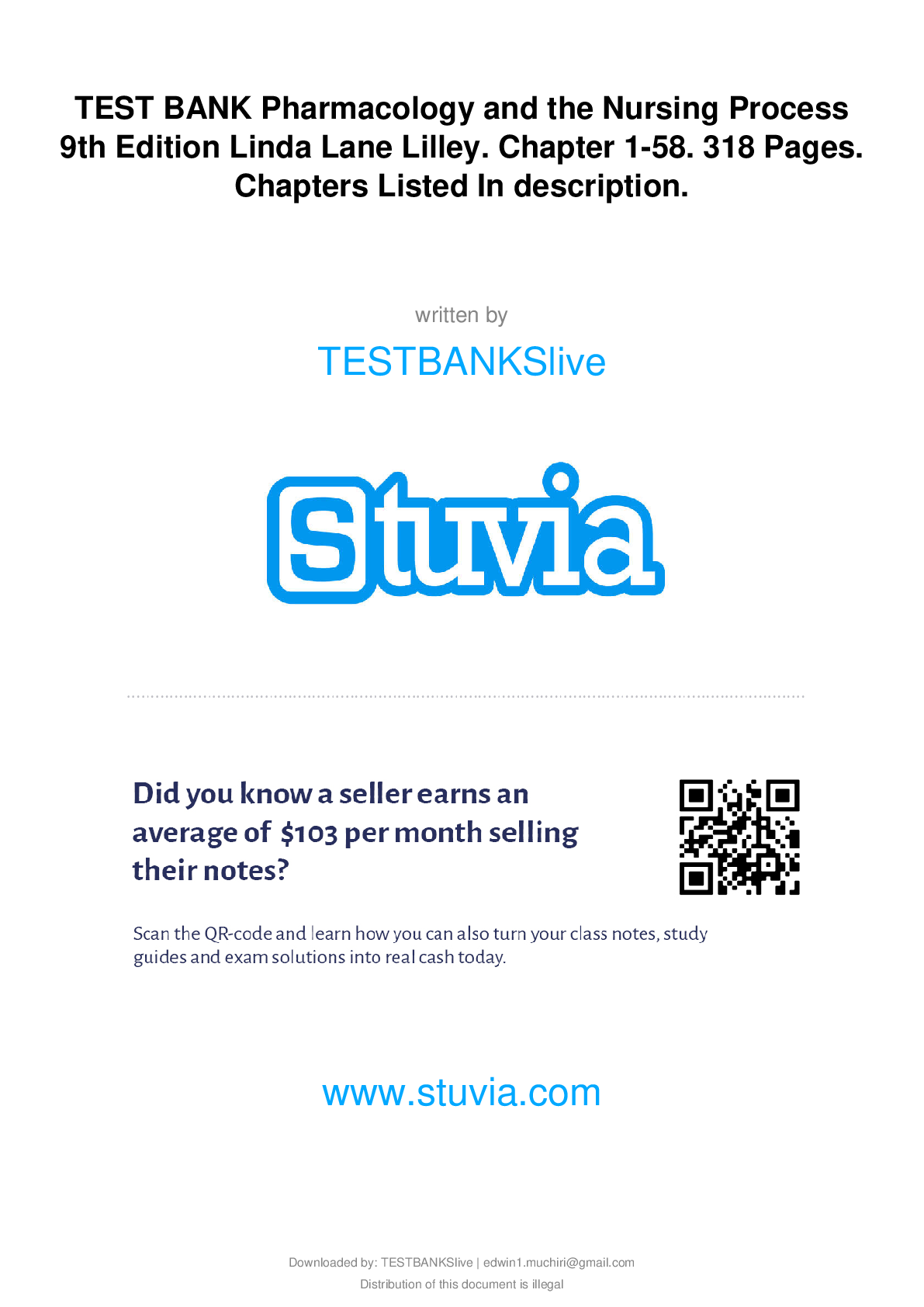
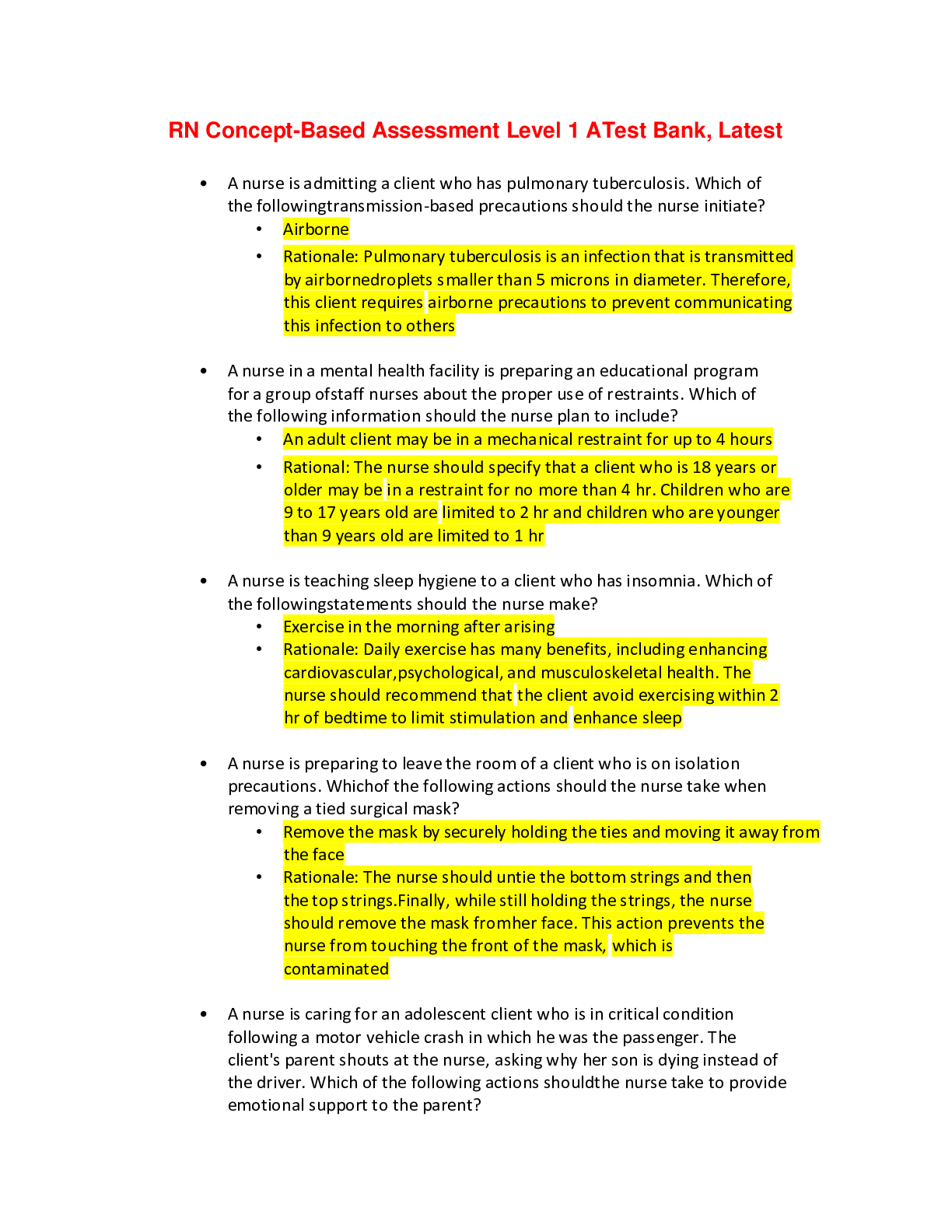
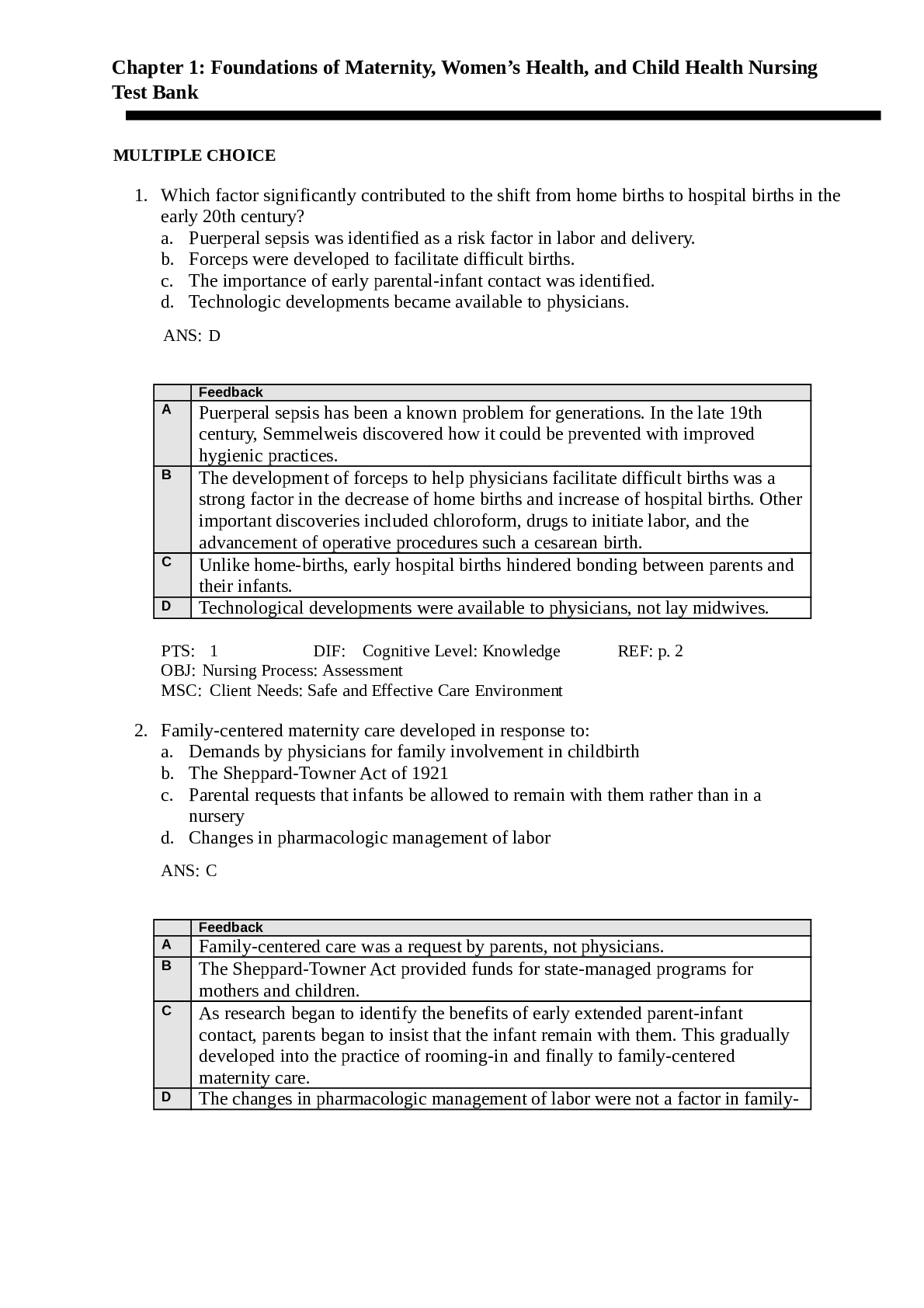
.png)
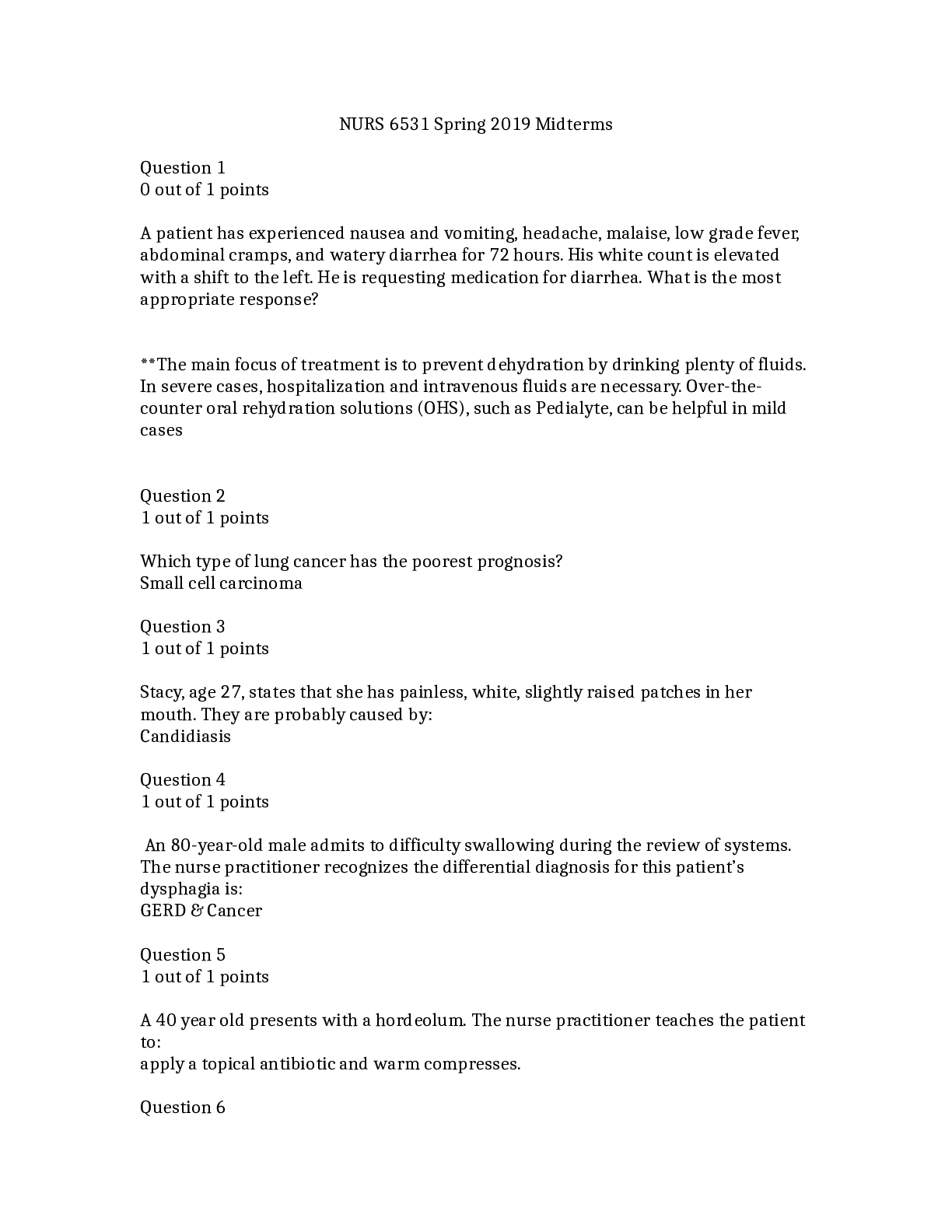
.png)
.png)
.png)
